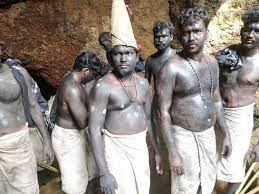Tipu sulthan, the tiger of Mysore dynasty. he was the ruler
of the kingdom of Mysore based in south India. There was a very popular art form
playing Tipu sulthans army called as Alamikali. Alamikali was popular regional
art form in Kasaragod district. Alami kali is staged to commemorate the battle
of Karbala. Karbala war is an important event in the history of Islam. The
battle of Karbala was fought on 10 October 680 between the army of the second ummayid
Yazid and army of Husain ibn ali. So, the war between them culminated in the
popular art form of Alamikali. the physique of alamis is dark coloured with
white spots to scare onlookers. They will put on garlands of fruits and leaves
and long hats on the head adorned with purple chrysanthemum flowers. Costume of
alamikali is dhotis, attaining up to the knee and carrying wield small sticks
with bells attached. Alamis visit homes advance in squares drawn on the ground
and get preserve of alamis.
A confluence of unique
culture can be discerned in the artwork form. With non-Islamic rituals come across
way into alamikali. The alamis had to face stiff opposition and spiritual
restrictions. Gradually the Muslim neighborhood line-up itself from alamikali.
In 1963 a newspaper published that the alamikali used to be banned. Some part
of the pass culture that have to be located in alamikali had been idol worship,
deity’s setup on elephants in processions etc. alamikali which went previous non
secular boundaries used to be as soon as in essence a find out about in
togetherness. Even to this day alamikali stays a beacon of lighter in the
annals of human history.
There is a big history behind
alamikali that was the integral venue of alamikali is a Alamikali in Kasaragod.
Other than Alamikali celebrations are in addition carried out in chithari,
kottikulam, and kasargod. The regional Muslims households are predominant. The
most crucial center is alamipally. Which has no mosque. They have a rock lined
ground in the shape of a flame. The Muslims of hanefi sect, who talk Hindustani
languages organize and lead the ceremony. They are identified as sahibs or
tuliker. A member from one of the households used to be the wooded shut by
using way of potential of defend of the governor landlord in echikkanam. It is
from this household that a sequence of fakir sahibs such as Rasool sahib who
organize and invent alamikali in the face of art.the play was extensively popular
as a secular way of entertainment the area Hindus have a unique suited to
attribute in Muslim setup rituals.
The
way of performing Alamikali was they pass with inflated social gathering by way
of making loud sounds the use of bells and sticks. A pocket is carried
alongside with a deep bottomed vessel. Alamis by no means put on shoes. They
visit each and every domestic asking for alamis. After retaining the wallet down,
they dance Infront of each and every home without giving precedence to rhythm.
the song of Alamikali have a special tone and verse. The first line of the song
is “lassolyma … lasso. layma…layma. laymalo and also the last line of the song.
Conversation is also structured in the form of songs……









Comment (0)